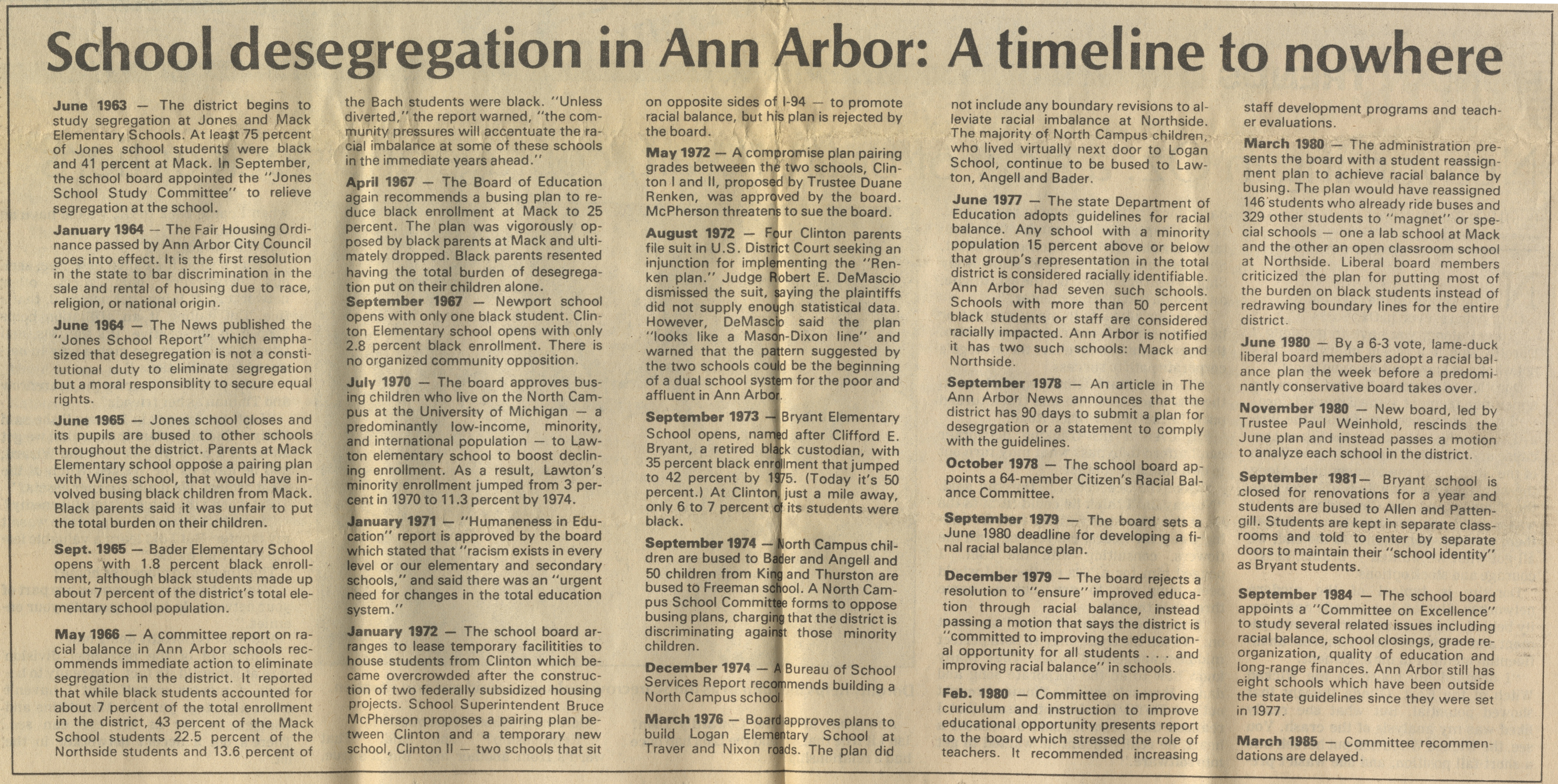The End Of A School Desegregation Order And Its Potential Consequences

Table of Contents
Historical Context of School Desegregation Orders
Understanding the potential consequences of ending a school desegregation order requires examining its historical context. The legacy of racial segregation in American schools is deeply rooted, stretching back to the post-Reconstruction era. The landmark Supreme Court case, Brown v. Board of Education (1954), declared state laws establishing separate public schools for black and white students to be unconstitutional. This pivotal ruling, however, was far from the end of the struggle. Implementation faced significant challenges and widespread resistance, highlighting the deeply entrenched nature of systemic racism.
The federal government, through various legislative and executive actions, and the federal court system, through court orders, played a crucial role in enforcing desegregation. These school desegregation orders mandated specific actions aimed at dismantling segregated school systems, often involving busing programs to achieve racial balance. However, the effectiveness of these orders varied widely across different regions and contexts.
- Brown v. Board of Education (1954): The landmark Supreme Court decision that declared state-sponsored segregation in public schools unconstitutional.
- Implementation Challenges and Resistance: Massive resistance to desegregation, including violent protests and legal challenges, hampered progress significantly.
- Long-term Effects of Segregation: Decades of segregation left a profound and lasting impact on educational opportunities and achievement gaps between racial groups.
- Examples of Successful Desegregation Initiatives: Some cities successfully implemented busing programs and other strategies to achieve meaningful integration, demonstrating the possibility of progress.
- Examples of Persistent Segregation Despite Court Orders: Despite court orders, many school districts continued to exhibit high levels of segregation, highlighting the complexities and challenges of achieving racial integration.
Immediate Consequences of Lifting a School Desegregation Order
The immediate consequences of lifting a school desegregation order are arguably the most concerning. The most significant potential impact is the re-segregation of schools. Without court-mandated integration efforts, schools are likely to reflect existing residential segregation patterns, leading to a resurgence of predominantly minority and predominantly white schools. This re-segregation will likely exacerbate existing achievement gaps. Schools with predominantly minority student populations often face challenges in terms of funding, resources, and teacher quality, which can negatively affect student outcomes.
- Increased Racial Segregation in Schools: The lifting of desegregation orders will likely lead to a rapid increase in racial segregation across many school districts.
- Achievement Gaps Widening: Re-segregation will likely widen the already significant achievement gaps between white and minority students.
- Unequal Access to Resources and Programs: Minority-majority schools often lack access to essential resources like advanced placement courses, specialized programs, and experienced teachers.
- Potential for Increased School Violence and Disciplinary Issues: Research suggests that segregated schools can contribute to increased tensions and conflict between different racial groups, potentially leading to higher rates of school violence and disciplinary problems.
Long-Term Societal Impacts of Ending School Desegregation Orders
The long-term societal impacts of ending school desegregation orders extend far beyond the immediate consequences within the educational system. The potential for increased social inequality and economic disparities is significant. Segregated schools perpetuate cycles of poverty and disadvantage, limiting social mobility for minority students and hindering their future economic prospects. This, in turn, can lead to increased political polarization and social unrest.
- Perpetuation of Systemic Racism and Inequality: The end of desegregation orders risks reinforcing systemic racism and perpetuating inequalities that have plagued American society for generations.
- Reduced Social Mobility for Minority Students: Segregated schools can significantly limit the social and economic opportunities available to minority students, hindering their ability to climb the socioeconomic ladder.
- Increased Political Polarization: Racial disparities in education can contribute to increased political polarization and social divisions.
- Negative Impacts on Community Relations and Social Capital: Segregation can erode social cohesion and diminish social capital within communities by limiting interracial interaction and understanding.
The Role of Community Involvement in Maintaining Integration
While court-ordered mandates have played a significant role in promoting school desegregation, the long-term success of integration ultimately depends on community involvement. Strategies for maintaining diversity and integration in schools without court-ordered mandates are crucial. Community engagement and collaboration are key to fostering a supportive environment for integration. Successful models of community-led initiatives demonstrate the power of proactive measures.
- Open Enrollment Programs: Allowing students to choose schools outside their immediate neighborhood can help promote diversity.
- Magnet Schools: Specialized schools that offer unique academic programs can attract students from diverse backgrounds.
- Community-Based Partnerships: Collaborations between schools, community organizations, and parents can create supportive learning environments.
- Increased Parental Involvement: Engaging parents from all backgrounds is essential for creating a shared commitment to integration.
Conclusion
The end of a school desegregation order presents a complex challenge with far-reaching consequences. While the lifting of such orders may be seen by some as a return to local control, the potential for increased segregation and its resulting negative impacts on students and society cannot be ignored. Maintaining racial integration in schools requires proactive measures, community involvement, and a continued commitment to creating equitable educational opportunities for all children. We must actively work to prevent the resurgence of segregation and ensure that all students have access to high-quality education, regardless of race or socioeconomic background. Understanding the potential consequences of ending a school desegregation order is crucial in shaping effective policies and strategies for a more just and equitable future. Let's continue the dialogue on the importance of school desegregation and find solutions to prevent its unraveling. The future of equitable education depends on our collective commitment to upholding the principles of Brown v. Board of Education and actively combating the resurgence of school segregation.

Featured Posts
-
 Tuerkiye Avrupa Is Birligi Yeni Bir Doenemin Baslangici
May 03, 2025
Tuerkiye Avrupa Is Birligi Yeni Bir Doenemin Baslangici
May 03, 2025 -
 157 Iyat Gol Na Lakazet Rekord I Ambitsii Za Lion
May 03, 2025
157 Iyat Gol Na Lakazet Rekord I Ambitsii Za Lion
May 03, 2025 -
 Astwl Alhryt Alkhlfyt Walntayj Almtrtbt Ela Alhjwm Alisrayyly
May 03, 2025
Astwl Alhryt Alkhlfyt Walntayj Almtrtbt Ela Alhjwm Alisrayyly
May 03, 2025 -
 Graeme Sounesss Channel Swim A Daring Feat For Isla
May 03, 2025
Graeme Sounesss Channel Swim A Daring Feat For Isla
May 03, 2025 -
 From Celeb Traitors To Bbc Daisy May And Charlie Coopers Next Venture
May 03, 2025
From Celeb Traitors To Bbc Daisy May And Charlie Coopers Next Venture
May 03, 2025
Latest Posts
-
 Rupert Lowe For Reform A Necessary Change Of Leadership
May 04, 2025
Rupert Lowe For Reform A Necessary Change Of Leadership
May 04, 2025 -
 Netherlands Hosts Lion Storages 1 4 G Wh Battery Energy Storage System Financial Close Achieved
May 04, 2025
Netherlands Hosts Lion Storages 1 4 G Wh Battery Energy Storage System Financial Close Achieved
May 04, 2025 -
 Wind Powered Trains Reducing Pollution And Saving Energy
May 04, 2025
Wind Powered Trains Reducing Pollution And Saving Energy
May 04, 2025 -
 4 G Wh Bess Project In Netherlands Lion Storage Announces Financial Close
May 04, 2025
4 G Wh Bess Project In Netherlands Lion Storage Announces Financial Close
May 04, 2025 -
 Reform Party Leadership Why Farage Should Make Way For Lowe
May 04, 2025
Reform Party Leadership Why Farage Should Make Way For Lowe
May 04, 2025
